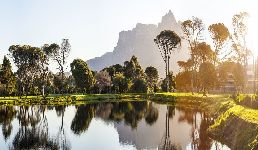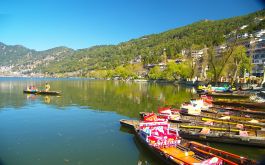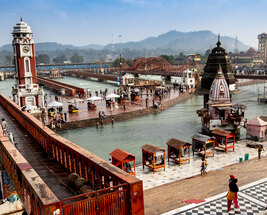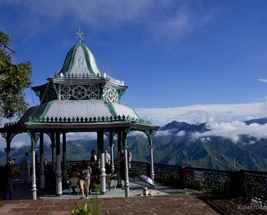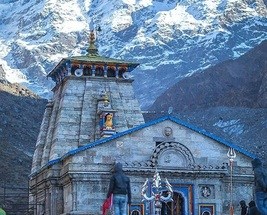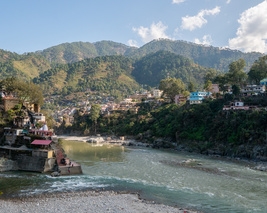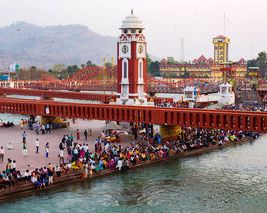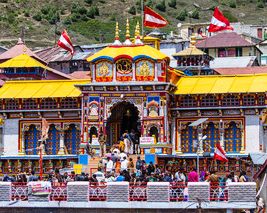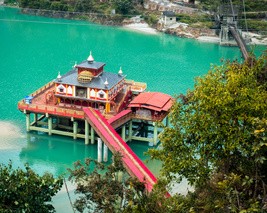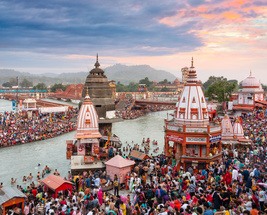If you have been thinking of making a spiritual vacation, then a pilgrimage to Haridwar tops the list. This beautiful place is one of the seven holiest destinations in India, and is visited by pilgrims from all corners of the globe. While the town experiences a moderate climate all through the year, the best time to visit Haridwar is between November and March as the weather is cool and pleasant when you are out exploring the place.
Like we said earlier, Haridwar is a holy destination and it has its share of religious festivals. If you are visiting as a pilgrim, then the months of July and October are ideal. You can also experience some of its religious fervour between March and May.
If you wish to simply explore the place and are planning to be there just for a vacation, then the best time to visit Haridwar is between October and February. The weather is wonderful and the rush is slightly reduced.
Haridwar is a beautiful destination for a holiday, whether or not you are spiritually inclined. Irrespective of which season you decide you visit Haridwar, we are sure that you will have an amazing time.
Summer Season (March-May)
If you wish to partake in the festivals of Haridwar then summer is the best season to visit. Ramanavami, Kanwar Mela and the Kumbh Mela are all celebrated in summer when the day is hot but the evenings are cool. If your only wish is to go sightseeing, then winter is a good time when the sun isn’t harsh. But do come prepared with woollens as winter can get chilly.
Monsoon Season (July-September)
Haridwar gets a moderate rainfall which actually increases the humidity of the place. While the rainfall isn’t much it can still lead to landslides and blocked roads. We do not recommend traveling to the town during these three months.
Winter Season (October-February)
Winter is the best season to visit Haridwar and it welcomes tourists with a cool, crisp climate all the way from October till February. The sun shines warmly on your back, making daytime just perfect for exploring the place, or from hopping from one temple to another.
|
Travel Seasons
|
Min/Max Temperature
|
Season
|
|
March to May
|
12-40 degrees
|
Summer - Hot and humid
|
|
July to September
|
15-25 degrees
|
Monsoon - Moderate rainfall
|
|
October to February
|
5-30 degrees
|
Winter - Pleasant and inviting
|
Haridwar in Summers (March to May)
Temperature: Avg. of 40 degrees high to 12 degrees low
Weather: If you can brave a little bit of the heat and humidity, then the weather of Haridwar in summer is actually a good time to visit. Summer starts of beautifully in March when the weather is good for travel and outdoor sightseeing. Blue skies and a warm sun will accompany you wherever you go. It starts to heat up in April and daytime in May can be uncomfortably warm. However, evenings are breezy and cool, and you can enjoy an unhurried walk along the river shore and also watch an aarti being performed at the same time.
Significant events: Everyone has heard of the Kumbh Mela, one of the most revered festivals in India. What makes it more unique is that the festival is celebrated just once in 12 years in Haridwar. The festival attracts holy men and religious devotees throng the place in the months from March to April. Do you know that the city has seen crowds of over 70 million people! It is believed that if you submerge yourself in the Holy Ganges during the Kumbh Mela you will be absolved of all your crimes and sins. There is also an Ardh Kumbha Mela (half Kumbh Mela) that is held in Haridwar every six years.
Why you should visit now: If you skip the festival time, summer in Haridwar can be a pleasant and peaceful time. Additionally, since it is not peak tourist season, you can get some great deals on hotels too.
Know before you visit: Once Kumbh Mela arrives Haridwar is packed to the gills with pilgrims as well as many foreign visitors who use this opportunity to capture amazing photographs. Book your tickets in advance to avoid disappointment.
Tips: When you step out during the daytime, ensure that you are adequately covered up and apply a liberal amount of sunblock.
Haridwar in Monsoon (July to September)
Temperature: Avg. of 25 degrees high to 15 degrees low
Weather: Haridwar is drenched in the monsoon and it completely changes the look of the city. The temperature drops and it is quite pleasant during the daytime. However, the weather in monsoon of Haridwar does not make it convenient to travel as the arrival of the rains also means landslides and roadblocks that can play spoilsport with your vacation plans. If you are looking just for a quiet getaway then you can consider Haridwar. It looks amazing once it has been washed clean by the storms. And of course, if you love the rain, then you will certainly have a good time in Haridwar.
Significant events: Haridwar is a pilgrimage destination and it continually hosts several religious festivals, one of which is the Kanwar Mela. This is an annual festival usually held in the month of July when it is Shravan and Phagun according to the Hindu calendar. Haridwar is inundated with thousands of pilgrims who have travelled by foot from various parts of India in the hopes of getting good karma. Their aim is to collect holy water from Ganga during the festival.
Why you should visit now: Monsoon is not one of the more popular seasons for traveling to Haridwar. If you are on a tight budget this can be a good time as you will get special offers and discounted rates on hotels and tour packages.
Know before you visit: Haridwar might receive moderate rainfall but it can throw travel plans out of gear. Many areas get blocked due to landslides, and most activities are also shut for the season.
Tips: Carry an umbrella and be prepared with other adequate rain gear when stepping outdoors.
Haridwar in Winter (October to February)
Temperature: Avg. of 30 degrees high to 5 degrees low
Weather: Haridwar during winter is invigorating. Not just because of the weather but also because of the numerous activities that you can enjoy in this place during these cold months. Winter mornings are perfect for sightseeing or for going on a pilgrimage tour in the city. The sky is clear, the sun is shining warmly and there is a mild breeze blowing. As winter progresses the temperature continues to drop further and it can get quite cool in the evenings once the sun sets. Be prepared and carry a thin jacket or shawl. Plan your pilgrimage tours at dawn and go sightseeing during the day to make the most of your time in Haridwar.
Significant events: Like most places in India, Haridwar too celebrates Diwali. However, it is Kartik Purnima, held on a full moon night, 15 days after Diwali that is a festival to be experienced. The festival is dedicated to God Vishnu and the whole town prays at the Ganga river. The evening is characterised by people floating diyas in the river water which makes for a beautiful experience.
Haridwar celebrates Holi with as much enthusiasm as the rest of north India. There is much pomp and show, and if you are visiting Haridwar during February and March, you will get a chance to experience it first-hand. The city comes alive in hues of all kind during the day as everyone sets out to colour each other. The festival moves to the bank of the Ganges where people eventually take a bath in the river to cleanse themselves.
Why you should visit now: Haridwar is best enjoyed during the winter months. The weather is just perfect, there are numerous festivals and you can explore the city to your heart’s content without the climate coming in the way of having a good time.
Know before you visit: Many people visit Hardwar in winter and it will be a good idea to book your tickets in advance to avoid getting disappointed.
Tips: Haridwar is not a very cold place even in winter but you will feel the nip in the evening and early morning. Pack a few warm jackets, heavy woollens and boots to be comfortable as you move about enjoying all that the city has to offer.
Haridwar is a beautiful town located on the plains of the Ganges and it is a popular pilgrimage destination for many Indians. Whether you feel the tug of holiness or not, visiting Haridwar once in your life is a wonderful idea. At Thomas Cook, we can help you plan and enjoy your vacation to Haridwar. Browse through our special Haridwar Tour Packages and begin planning for your vacation to this land of spirituality right now. We can also assist you with your tickets and hotel accommodation if you wish.








